当前位置:
X-MOL 学术
›
Food Sci. Nutr.
›
论文详情
Our official English website, www.x-mol.net, welcomes your
feedback! (Note: you will need to create a separate account there.)
Metabo groups in response to micronutrient intervention: Pilot study.
Food Science & Nutrition ( IF 3.5 ) Pub Date : 2019-12-19 , DOI: 10.1002/fsn3.1357 Carolina Almeida Coelho-Landell 1 , Roberta Garcia Salomão 1 , Maria Olimpia Ribeiro do Vale Almada 1 , Mariana Giaretta Mathias 1 , Roseli Borges Donega Toffano 1 , Elaine Hillesheim 1 , Tamiris Trevisan Barros 1 , Joyce Moraes Camarneiro 1 , José Simon Camelo-Junior 1 , José Cesar Rosa 2 , Clarice Izumi 2 , Érika Czernisz 2 , Sofia Moco 3 , Jim Kaput 3, 4 , Jacqueline Pontes Monteiro 1
Food Science & Nutrition ( IF 3.5 ) Pub Date : 2019-12-19 , DOI: 10.1002/fsn3.1357 Carolina Almeida Coelho-Landell 1 , Roberta Garcia Salomão 1 , Maria Olimpia Ribeiro do Vale Almada 1 , Mariana Giaretta Mathias 1 , Roseli Borges Donega Toffano 1 , Elaine Hillesheim 1 , Tamiris Trevisan Barros 1 , Joyce Moraes Camarneiro 1 , José Simon Camelo-Junior 1 , José Cesar Rosa 2 , Clarice Izumi 2 , Érika Czernisz 2 , Sofia Moco 3 , Jim Kaput 3, 4 , Jacqueline Pontes Monteiro 1
Affiliation

|
Micronutrients and their metabolites are cofactors in proteins involved in lipid metabolism. The present study was a subproject of the Harmonized Micronutrient Project (ClinTrials.gov # NCT01823744). Twenty participants were randomly selected from 136 children and adolescents that consumed a daily dose of 12 vitamins and 5 minerals supplementation for 6 weeks. The 20 individuals were divided into two pools of 10 individuals, according to their lipid profile at baseline (Pool 1 with lower triglycerides, LDL, and VLDL). The individuals were analyzed at baseline, after 6 weeks of daily supplementation, and after 6 weeks of a washout period in relation to anthropometric, body composition, food intake, lipid profile, micronutrient levels, and iTRAQ proteomic data. Genetic ancestry and its association with vitamin serum levels were also determined. After supplementation, LDL levels decreased while alpha‐tocopherol and pantothenic acid levels increased in pool 2; lipid profiles in pool 1 did not change but had higher plasma levels of pantothenic acid, pyridoxal, and pyridoxic acid. In pool 2, expression of some proteins increased, and expression of other ones decreased after intervention, while in pool 1, the same proteins responded inversely or did not change their levels. Plasma alpha‐tocopherol and Native American genetic ancestry explained a significant fraction of LDL plasma levels at baseline and in response to the intervention. After intervention, changes in expression of alpha‐1 antitrypsin, haptoglobin, Ig alpha‐1 chain C region, plasma protease C1 inhibitor, alpha‐1‐acid glycoprotein 1, fibrinogen alpha, beta, and gamma‐chain in individuals in pool 2 may be associated with levels of LDL and vitamin E. Vitamin E and Native American genetic ancestry may also be implicated in changes of vitamin E and LDL levels. The results of this pilot study must be validated in future studies with larger sample size or in in vitro studies.
中文翻译:

代谢组对微量营养素干预的反应:试点研究。
微量营养素及其代谢物是参与脂质代谢的蛋白质的辅助因子。本研究是协调微量营养素项目 (ClinTrials.gov # NCT01823744) 的一个子项目。从 136 名儿童和青少年中随机抽取 20 名参与者,每天服用 12 种维生素和 5 种矿物质补充剂,持续 6 周。根据基线时的血脂情况,这 20 个人被分为两组,每组 10 人(组 1 具有较低的甘油三酯、LDL 和 VLDL)。在基线、每天补充 6 周后以及 6 周清洗期后,对个体进行了人体测量、身体成分、食物摄入、血脂、微量营养素水平和 iTRAQ 蛋白质组数据的分析。还确定了遗传血统及其与维生素血清水平的关联。补充后,第 2 组中 LDL 水平下降,而 α-生育酚和泛酸水平上升;池 1 中的脂质谱没有变化,但泛酸、吡哆醛和吡哆酸的血浆水平较高。在池2中,干预后一些蛋白质的表达增加,而其他蛋白质的表达减少,而在池1中,相同的蛋白质反应相反或没有改变其水平。血浆 α-生育酚和美洲原住民遗传血统解释了基线时和对干预的反应中 LDL 血浆水平的很大一部分。干预后,第 2 组个体中 α-1 抗胰蛋白酶、触珠蛋白、Ig α-1 链 C 区、血浆蛋白酶 C1 抑制剂、α-1-酸性糖蛋白 1、纤维蛋白原 α、β 和 γ 链表达的变化可能与 LDL 和维生素 E 水平有关。 维生素 E 和美洲原住民遗传血统也可能与维生素 E 和低密度脂蛋白水平的变化有关。这项试点研究的结果必须在未来更大样本量的研究或体外研究中得到验证。
更新日期:2019-12-19
中文翻译:

代谢组对微量营养素干预的反应:试点研究。
微量营养素及其代谢物是参与脂质代谢的蛋白质的辅助因子。本研究是协调微量营养素项目 (ClinTrials.gov # NCT01823744) 的一个子项目。从 136 名儿童和青少年中随机抽取 20 名参与者,每天服用 12 种维生素和 5 种矿物质补充剂,持续 6 周。根据基线时的血脂情况,这 20 个人被分为两组,每组 10 人(组 1 具有较低的甘油三酯、LDL 和 VLDL)。在基线、每天补充 6 周后以及 6 周清洗期后,对个体进行了人体测量、身体成分、食物摄入、血脂、微量营养素水平和 iTRAQ 蛋白质组数据的分析。还确定了遗传血统及其与维生素血清水平的关联。补充后,第 2 组中 LDL 水平下降,而 α-生育酚和泛酸水平上升;池 1 中的脂质谱没有变化,但泛酸、吡哆醛和吡哆酸的血浆水平较高。在池2中,干预后一些蛋白质的表达增加,而其他蛋白质的表达减少,而在池1中,相同的蛋白质反应相反或没有改变其水平。血浆 α-生育酚和美洲原住民遗传血统解释了基线时和对干预的反应中 LDL 血浆水平的很大一部分。干预后,第 2 组个体中 α-1 抗胰蛋白酶、触珠蛋白、Ig α-1 链 C 区、血浆蛋白酶 C1 抑制剂、α-1-酸性糖蛋白 1、纤维蛋白原 α、β 和 γ 链表达的变化可能与 LDL 和维生素 E 水平有关。 维生素 E 和美洲原住民遗传血统也可能与维生素 E 和低密度脂蛋白水平的变化有关。这项试点研究的结果必须在未来更大样本量的研究或体外研究中得到验证。











































 京公网安备 11010802027423号
京公网安备 11010802027423号